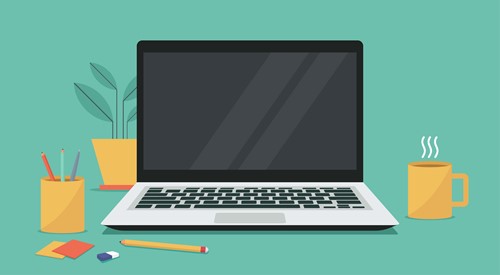According to one study, as many as 90% of people who work at computer screens in the UK have symptoms of digital eye strain.
Another study has shown that nearly 1 in 5 teenagers in the UK are now myopic (i.e. short sighted). That’s over twice as many than in the 1960s.
And it’s not just the UK that has this problem. The eyesight of Japanese students has declined significantly in recent years, with the blame landing squarely on smartphone use.
But why are screens so bad for you? What’s the real damage to your eyes? And what are you going to do protect your workers’ vision? Keep reading to find out.

Blue light: beautiful, but potentially deadly
You’ve probably heard that smartphones and laptops emit blue light. Sounds innocent enough. Except some researchers suggest it might be poisoning your eyes.
According to new research, when blue light hits your eyes it could set off a biochemical chain reaction that permanently destroys cells in your retina.
The death of light sensitive cells in the eye is called macular degeneration. It’s incurable and it leads to vision loss in about 2.4% of UK adults.
So how do you stop it?
Researchers recommend that you don’t use your smartphone or tablet when it’s dark. And you can reduce exposure to blue light during the day time, too, by adjusting your computer. For example, most PCs and laptops have settings that can remove blue light from the screen.
Some experts suggest you go further even to protect your eyes and wear sunglasses whenever you’re outside. This will filter out blue light that occurs naturally and have the added benefit of making you look really cool (possibly...).
Screens are dangerous: keep your distance
Human eyes have an incredible range of vision. Sure, it’s not quite as impressive as other animals (did you know that a goat’s vision can cover up to 340 degrees?) but it’s still quite spectacular.
For example, on a dark night, assuming there’s nothing blocking your view, you’d be able to make out a flickering candle up to 3 kilometres away. Then you could instantly adjust your focus to look at your watch less than a foot away.
We can make that massive switch from long to short distance vision because of the muscles in our eyes. They contract when we look at things close up and relax when we look far away.
So if you’re staring at a computer screen for 8 hours a day your eye muscles are permanently contracted. That’s one reason why as many as 90% of UK adults suffer digital eye strain.
Digital eye strain isn’t quite as scary as permanent retinal death, but it’s still serious. It can cause fatigue, headaches, blurred vision, dry eyes and neck pain. And workers who are in constant pain do not make efficient workers.
Fortunately, there’s a simple solution. Set up your computer screen at a comfortable distance (one study recommends between 52cm and 73 cm) and take regular breaks. You and your workers should try to take your eyes away from the screen for 20 seconds every 20 minutes. And remember, you need to give workers at least one 15-minute break for every 4 ½ hours they work.
P.S. When your staff take breaks from their computer screens, encourage them not to spend their break looking at their phones. That defeats the point.
Your legal responsibilities to protect eyesight at work
In the grand scheme of human existence, staring at a screen all day is a new phenomenon. And there’s a lot of misinformation out there about the impacts of long-term screen use.
As always, the best way to protect yourself and your staff is by taking sensible health & safety actions.
For example, all your workers need to complete display screen equipment (DSE) checks when they start work, and these should be updated as required, i.e. after significant changes and at regular refresher intervals. This will help them to set up their screens and workstations to prevent discomfort.
You must also pay for employees that use screens to take an eye test if they ask for one. You may need to pay for their glasses, too, if tests show that an employee needs a special prescription to see the screen they use. But you don’t need to pay for a standard prescription.
Health & Wellbeing of Desk Workers
The health & wellbeing of desk workers is often overlooked. But a poorly designed or arranged workstation could put your staff at risk of discomfort, back or neck pain, and other musculoskeletal disorders.
Reading the screen
Make sure the words and images on the screen are sharp, in focus, and don’t flicker or move. If the screen isn’t clear, the display screen equipment (DSE) may need adjusting or servicing.
- Make sure the screen surface is clean
- Adjust the brightness and contrast controls on the screen to suit the lighting conditions of the room
- When setting up software, choose text that’s large enough to read easily
- Make sure the top of the monitor is eye level to avoid head tilting or neck strain
Using a mouse
- Position the mouse within easy reach to avoid stretching or wrist strain
- Move the keyboard out of the way when not in use
- Support the forearm on the desk
- Don’t grip the mouse too tightly or press the buttons too hard
Using a keyboard
- Keep wrists straight when typing
- Leave a space in front of the keyboard for resting hands
- Type softly
- Don’t overstretch the fingers
What training should you give?
You must provide information and health & safety training to all desk workers. The right training helps identify risks and encourages safe work practices. When training people, consider explaining:
- The risks of DSE work
- The safety measures in place
- How to adjust furniture
- How to organize the workstation to avoid awkward or repeat stretching movements
- How to clean the screen and mouse
- Who to contact to get support or report problems
- How to complete a DSE workstation checklist
Find out more about protecting your eyes at work
You can’t force your employees to set up their desk properly or take an eye test. But it’s in your interest to raise awareness of the risk to their eyesight. Not only is it your legal responsibility, but better working conditions make happier and more productive employees.
For more practical tips on how to protect health & wellbeing at work, contact Croner.
We offer a FREE health & safety advice service for businesses. So whatever workplace challenge you face, call our friendly team of experts today for instant, no obligation advice. Call a Croner health & safety expert on 0800 141 3809.
Related resources
Categories
- Business Advice
- Culture & Performance
- Disciplinary & Grievances
- Dismissals & Conduct
- Employee Conduct
- Employment Contracts and Documentation
- Employment Law
- Employment Rights Bill
- End of Contract
- Equality & Discrimination
- Health & Safety
- Hiring and Managing
- Leave & Absence
- Managing Health & Safety
- Moving
- Occupational Health
- Pay & Benefits
- Recruitment
- Risk & Welfare



